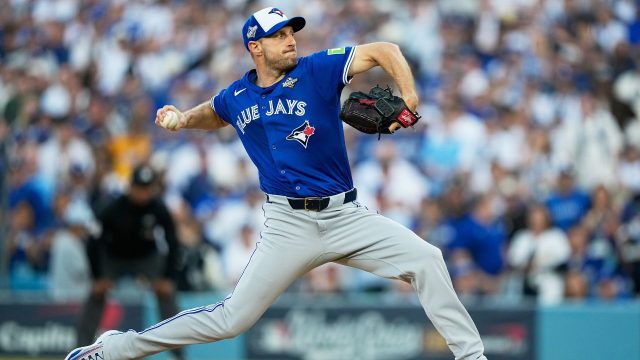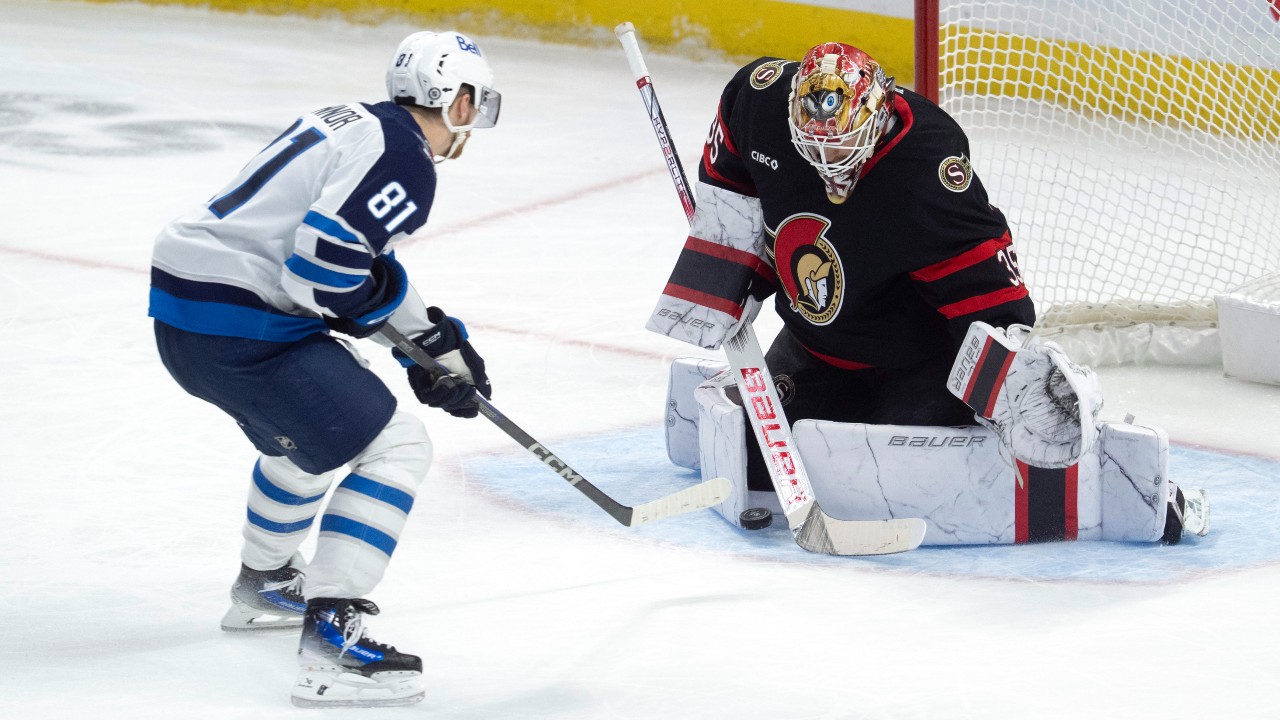
TORONTO — There are only two outcomes now. Either the Toronto Blue Jays achieve one of the greatest triumphs in franchise history, revelling in the sheer ecstasy of winning a World Series on home turf against MLB’s modern-day dynasty, or they suffer the crushing disappointment and intense heartbreak of getting this close to a first title in 32 years only to let it escape their grasp.
There is no in between. The rare opportunity of watching multiple future Hall-of-Famers competing in the seventh game of the World Series — there have been only 40 instances in the sport’s 122-year history — will be little solace for anyone emotionally invested in the losing side.
It’s a zero-sum game that ZiPS gives the Dodgers a 54.6 per cent chance of winning. With a margin so thin, every percentage point you gain matters. Here’s how the Blue Jays can try to tip those scales in their favour.
-

-
Watch the Blue Jays in the World Series on Sportsnet
It all comes down to Game 7 as the Blue Jays try to win their first World Series title since 1993. Watch Game 7 on Saturday at 8 p.m. ET / 5 p.m. PT on Sportsnet and Sportsnet+.
How should the Blue Jays line things up against the Dodgers’ pitching staff?
Starters
George Springer — DH
Nathan Lukes — LF
Vladimir Guerrero Jr. — 1B
Bo Bichette — 2B
Addison Barger — RF
Alejandro Kirk — C
Daulton Varsho — CF
Ernie Clement — 3B
Andres Gimenez — SS
Finishers
Tyler Heineman
Davis Schneider
Ty France
Isiah Kiner-Falefa
Myles Straw
The Dodgers haven’t named a Game 7 starter, which makes constructing a lineup difficult. But the most logical thing for them to do is start — perhaps more accurately, open — Shohei Ohtani, so we’re building it as if he’s the matchup.
Pitching on three days’ rest, Ohtani won’t be in the game for long. Particularly considering he’s coming off Tommy John surgery and didn’t pitch on regular rest once this year. But it would be foolish for the Dodgers not to incorporate one of the world’s most talented arms into their pitching plan in some fashion.
The issue they must work around is an MLB rule that states a two-way player, such as Ohtani, can remain in a game as their team’s designated hitter after finishing an outing as a starting pitcher, but not after entering as a reliever. In that scenario, the Dodgers would lose their designated hitter once Ohtani concluded his outing.
There are a couple of workarounds to that, such as a double switch or having Ohtani play the outfield, as he did regularly in NPB and for a handful of innings with the Angels in 2021. He could also serve as a closer, as he did for Japan to secure a gold medal at the 2023 World Baseball Classic, if the Dodgers have a late lead. But that would necessitate the careful calculus of how Ohtani warms up during a game he may need to hit in. A much cleaner deployment is to simply have him start and shift to DH afterwards.
Playing through too many ailments to list, George Springer did that thing in Game 6 where he looks insanely uncomfortable in his first plate appearance then rips his hardest hit ball in weeks his next time up (at 109.8-m.p.h., Springer’s third-inning single off Yoshinobu Yamamoto was his third-hardest hit ball of the post-season) so he’s gutting through one more game and looking for yet another classic October performance despite the fact its November now.
The lefties are in to face Ohtani, but they may only get one crack at him before they’re encountering Justin Wrobleski, Jack Dreyer, or Anthony Banda. The Blue Jays have had plenty of success against Banda in the series, but Dreyer hasn’t allowed a run in his two appearances, while Wrobleski has been phenomenal, allowing only two baserunners over 3.2 innings while nullifying barrels and running a 78 per cent groundball rate.
That could put Schenider in a tough spot, weighing how early is too early to pinch-hit with Davis Schneider or Ty France. He may have to accept an unideal matchup in Lukes’ or Gimenez’s second trip because their defence is valuable and there’s bound to be right-handers coming out of the Dodgers bullpen later in the game.
We’re not mentioning Addison Barger in that breath because he’s elevated himself beyond a platoon role. He’s hitting .476/.500/.714 in the World Series and has a 17.6 per cent chase rate since the beginning of the ALCS, the lowest in the post-season over that span. You’re keeping a bat like his in the game for as long as it goes, and you never know when he’ll get the opportunity to use his arm to make a game-changing play from right field.
You could even make a case for bumping Barger up into the two-hole in place of Lukes, who’s 4-for-20 with two walks in the series. But two of those four hits came off Ohtani, and Lukes has a .379 OBP against right-handed pitchers this post-season. Even the noisy, small-sample argument is in his favour.
How should the Blue Jays approach Ohtani? Well, you’re always hunting his fastball. Lefties get it around half the time. Righties might not see it as often as his sweeper, but good luck trying to hit that pitch as it breaks over a foot across the zone unless your name’s Vladimir and the typical rules don’t apply.
Four of Toronto’s six hits off Ohtani in Game 4 came against fastballs, and five of their nine hard-hit balls. Of course, it’s fair to expect Ohtani to make an adjustment after throwing 47 per cent heaters that night. But if he’s only in the game for a trip through the lineup, is he going to stray far from a pitch he could be throwing triple-digits in a shorter stint?
Ultimately, aggressiveness is the best approach against Ohtani, who isn’t hesitant with the zone. He throws plenty of pitches on the plate — his Game 4 zone rate was right in line with his season-long one at 52 per cent — particularly early in plate appearances. Ohtani’s most predictable in those 0-0 and 1-0 counts, when he’s throwing over 40 per cent fastballs.
What you don’t want to do is fall behind and end up in the difficult dilemma of guarding against seven distinct offerings ranging from 72 to 102 m.p.h. That’s how Ohtani’s able to get away with so much on the plate, as he did against the Blue Jays in Game 4:
We all love to extol the virtue of a disciplined, discerning plate appearance in which a hitter sees a half-dozen pitches and makes a pitcher labour. But if Ohtani’s getting outs, it doesn’t matter how hard he’s working for them when there’s no tomorrow and anyone sentient on the active roster is available to pitch.
Your best odds of getting an intentional swing off against a fastball are going to be early in the count. So, the Blue Jays should take their shots and try to do some early-inning damage.
How long will Max Scherzer’s leash be?
The Blue Jays gave Scherzer exactly two trips through the Dodgers’ order in his Game 3 start, and that’ll likely be his limit again this time around. If that knowledge allows him to come out hot like he did at Dodger Stadium, where he averaged 95.8 m.p.h. with his fastball in the first inning, great. There’s nothing to save anything for after this one.
And with every pitcher on the roster except for Kevin Gausman — and, really, he’d pitch if asked to — in play, Scherzer’s job is to be as nasty as possible as long as he’s on the mound. As romantic as it would be for Scherzer to turn back the clock and go seven innings, that isn’t happening Saturday. There’s too much at stake for Schneider to be deferential to a legend’s stubbornness or a moment’s emotion.
If a leverage point develops in the third or fourth inning, and there’s a pitcher in the Blue Jays bullpen who gives the team a better chance of getting a big out than the one on the mound, it’s a manager’s job to put his team in the best possible position to be successful. Regardless of the names on the backs of the jerseys. In games like these, you always want to lift a pitcher a batter too early rather than a batter too late.
Now, all that said, if Scherzer’s churning through outs in absolute command, there’s no reason to lift him before that third trip through the order. But remember, Saturday’s third look at Scherzer will actually be this lineup’s fifth in the series. Ohtani went 2-for-2 with a double and a homer against Scherzer in Game 2, and the Dodgers’ lineup as a whole went 3-for-8 with a walk in its second time seeing him.
Entering the night, you tell Scherzer he has 18 batters to face at most and to put all of his energy into making their lives as difficult as possible. There’s an entire roster of arms behind him to carry the baton from there.
How should the Blue Jays deploy their bullpen?
One of the most fun aspects of a Game 7 in MLB’s post-season is the starters who become relievers for a night. And for the Blue Jays, that will be Shane Bieber and Trey Yesavage, who you’ll see sitting out in the left field bullpen waiting for the phone to ring.
Bieber would likely be the preferred option to take over if Scherzer ran into trouble early or suffered an injury. He’ll be on only three days’ rest but could still log a substantial pitch count if circumstances called for it. He’s also the guy to give the ball to in extras if you’ve burned through many of your shorter-stint relievers to get there.
Yesavage, meanwhile, is better suited to a shorter, air-it-out appearance, as he’ll be only two days removed from his brilliant Game 5 performance. That’ll be a tempting card for Schneider to play regardless of game script, considering both how well the rookie performed against the Dodgers’ lineup and what his stuff could look like when throwing max effort in relief. The Blue Jays have already asked an awful lot of Yesavage this post-season. And it’s a strong possibility they ask for one more thing.
Meanwhile, Dave Roberts’s lineup adjustments over the last three games have made it difficult for the Blue Jays to mitigate the reliever familiarity penalty. Schneider had more fresh matchups entering Game 7 against the Mariners than he will Saturday night.
One he should absolutely avoid is Mason Fluharty against the top of the Dodgers lineup. Ohtani, Will Smith, and Freddie Freeman have each seen him three times in the series. Smith’s also seen Jeff Hoffman three times, while Freeman and Mookie Betts have seen him twice. Seranthony Dominguez has also faced that pocket repeatedly — Ohtani, Smith, and Betts would be seeing him a third time in Game 7.
A great option Schneider’s preserved, however, is Louis Varland, who’s been used repeatedly against the middle-to-bottom of L.A.’s order but has faced Ohtani, Smith, and Betts only once, while Freddie Freeman’s yet to see him. Chris Bassitt could also be useful against the top of the lineup, as he’s faced Ohtani, Betts, and Freeman just once in the series himself.
Ultimately, it’s the seventh time these two teams will have played one another in a nine-day span. There aren’t any secrets remaining between them. But wherever the Blue Jays can find an edge, they must seize it. Winner-take-all in a zero-sum game, you never know which percentage point will be the one to tip the scales in your favour.







